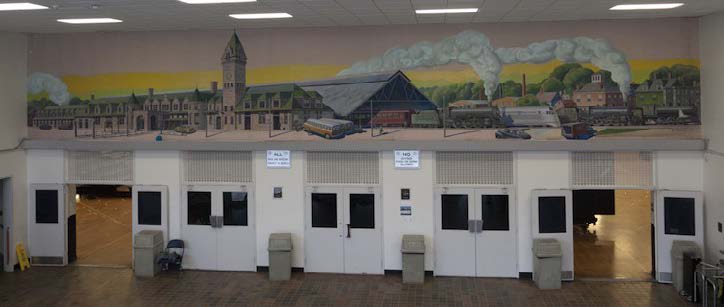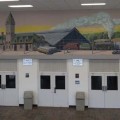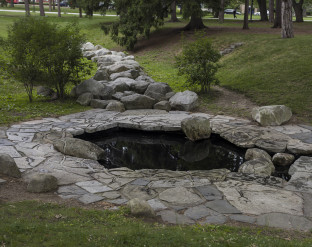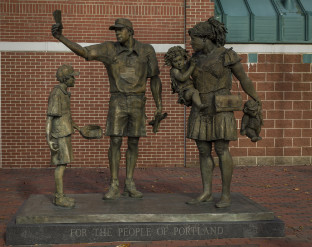Maine artist, Don Thayer, painted the mural on the wall above the doors leading into the Portland Expo auditorium in 1979. It depicts nearby Union Station, which stood from 1888 to 1961 on St. John Street on the site of the shopping plaza where Buckdancer’s Choice and Maine Hardware are now located.
Don Thayer painted the mural depicting Union Station and Libbytown in a little over six weeks in 1979 using acrylic paint and acrylic sealer. Thayer laid out a grid on the wall and used charcoal to sketch each section of this mural. Thayer graduated with a BFA cum laude from Syracuse University. He worked as an illustrator for McGraw-Hill and Ziff- Davis. Thayer taught at the Portland School of Art, which would later become MECA (Maine College of Art), and he lived with his family in Farmington.
Union Station was designed by architects Bradlee, Winslow and Witherell of Boston, and it was meant to resemble a medieval French chateaux. Commuter trains from Boston stopped at Union Station before heading on to Lewiston, Bangor and Waterville. Rail service ceased in 1960, and the station was demolished in 1961.
Union Station stood in the Libbytown neighborhood. Originally called Libby’s Corner, it was renamed Libbytown by the working class Irish Catholics who lived there. The Libbytown neighborhood encompasses an area from the West End where the Memorial Bridge crosses the Fore River from South Portland and meets the peninsula, to Stroudwater where Congress Street crosses the Fore River, to Dougherty Field on St. James Street near Brighton Avenue.
The demolition of Union Station served as a wake up call to those in the city interested in preserving Portland’s architectural character and heritage. The re-purposing of the Baxter Library building by the VIA Agency downtown, and other projects like it, is a direct outcome of balancing and preserving Portland’s unique architecture with the changing needs of the city.


 The Portland Expo, 239 Park Avenue
The Portland Expo, 239 Park Avenue






